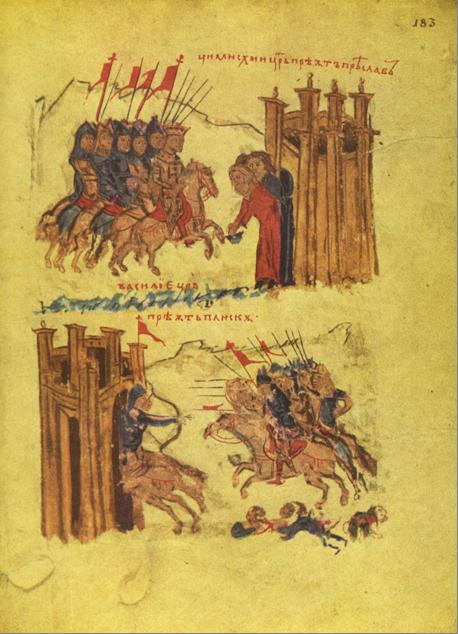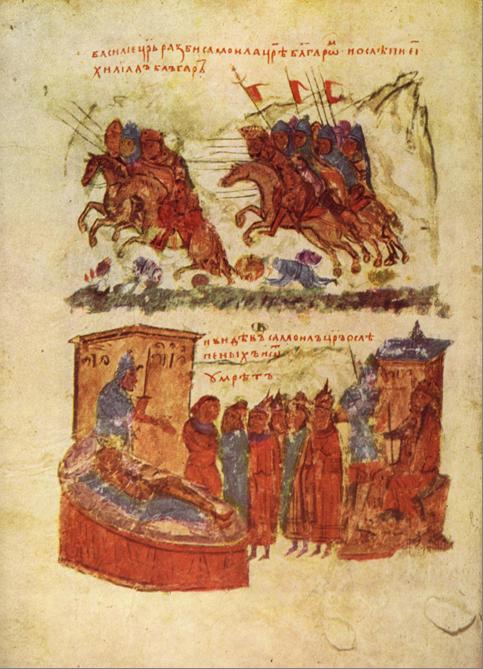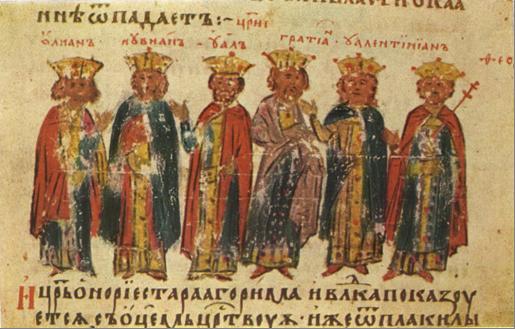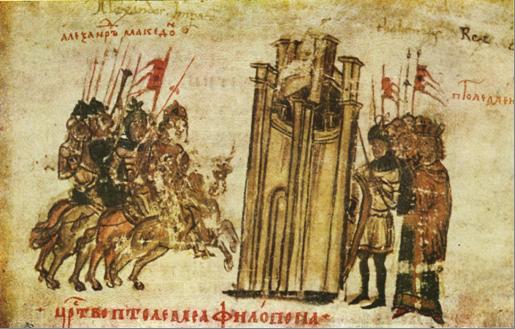
Reserved Area
Artists - ArtWorks
Bulgarian transcript of the Manasses Chronicl
 Bulgaria
BulgariaThe Reign of Ivan Alexander
An old-Bulgarian transcript of the Manasses Chronicle – preserved in the Vatican library; the author of the transcript is unknown; the original chronicle was produced by Constantine Manasses - a Byzantine chronicler who flourished in the 12th century; the works of art in the transcript are miniatures illustrating the Vatican translation of the Manasses Chronicle.
Art Period: Old-Bulgarian manuscript from 1344 – 1345 – the reign of Ivan Alexander. This period is determined as the Second golden Age of Bulgarian art /the first one was during the reign of Simeon/. In the capital of the Turnovo kingdom of that time operates the Turnovo art school, as a result of which are created exceptional manuscript cultural monument, some illustrated copiously with miniatures. This is the peak in the development of mediaeval Bulgarian miniature.
Ivan Alexander is one of the most important figures in the history of the Balkan peninsular during the 14 century, which is greatly due to his flexible dynastic policy. Just life John Kantakouzenos the tsar had preferences towards the hesychasts – Theodosius of Turnovo and his supporter Romil of Vidin. St. Theodosius of Turnovo, who is probably related to the royal family, becomes chief aid to the prominent hesychast St. Gregory Sinait /Palamas/. He meets twice with Ivan Alexander on his behalf. In “the royal city of the Bulgarians – Turnovo, second after Constantinople” he fights the heresies as leading accuser of adamits, followers of bogomilism, the doctrine of Varlaam an Akindin and the Judaists. Two councils (during 1350 and 1360) against them had been summoned by the tsar. With his help, Theodosius builds the monastery St. Trinity close to Turnovo.
The trade relations with Venice, Dubrovnik and Genoa, as well as the cultural life during the reign of Ivan Alexander are flourishing. The literary and artistic schools in Turnovo continue the old Bulgarian traditions. From the private royal library are preserved: the Laurentian collection of Ivan Alexander 1348., Kuklen Psalter, also called “Pesnivets”, as of 1337, the richly illustrated Tetraevangelia of Ivan Alexander (1355–1356), now exhibited in the British Library, London, Apostle with interpretations, two transcripts of the Trojan tale and others. Ivan Alexander had been praised several times by the Byzantine patriarch Calist in the “Pesnivets”. The tsar is a great supporter of literature and arts and makes many donations to churches and monasteries. He also establishes new ones. According to a legend, he established 14 new churches only in the Sofia region. During his reign Turnovo literary and art schools mark their peak.
The 14 century is the time of literary upheaval in Bulgaria. During this period the Tarnovo literary school, in which old-Bulgarian manuscripts, remarkably decorated with miniatures are created, is quite active. Together with their development is developed and established a new branch of the Tarnovo art school – painting miniatures as parts of the books ordered by the court. This is the time of Tsar Ivan Alexander – the greatest ktitor in Bulgarian history.
Miniature fine arts, which started its development in Bulgarian art from the end of the IX century / beginning of X century, reached its development peak in XIII-XIV century. Among the most important Bulgarian monuments of this artistic kind is the Tetraevangelia of Ivan Alexander, preserved in the British museum, the illustrated manuscript of the Bulgarian translation of Manasses chronicles (Cod. Vat. Slavo 2), the Tomich Psalter and other.
Manasses chronicle encompasses events from the creation of the world until the beginning of the reign of Byzantine emperor Alexius I Comnenus (1081-1118). The translation is not in verses and was done in the period 1344-1345 following the orders of Tsar Ivan Alexander (1331-1371) and has 19 additions related to the Bulgarian history. The text of this object /the Vatican copy/ is the only of all Slavic transcripts, which has been richly illustrated with 69 miniatures. The most precious part of this manuscript are the chronicle “glosses”, related to events from Bulgarian history, which are missing from the Byzantine original. 10 of the miniatures occupy full pages – in the beginning, middle and end of the text. In general, their plots are connected with biblical and eastern history, the Trojan war, the Roman, the Byzantine and the Bulgarian history. Some represent the relations between the Bulgarians and the Russians – the christening of the Russians and the invasion of the Kiev prince Svetoslav in Bulgaria /967 - 972/. 25 of them are not directly related to the text. Of great interest are the explanatory notes under the miniatures, which have not been made by the transcriber /as the practice was/, but by the artist – the miniaturist. Later, in the Vatican library, their translations in Latin have been added.
The miniatures are complex multi-figure compositions and contain multiple and various elements: conventionally presented natural landscapes /mountains, seas, hills, rivers/; architectural motives /palaces, cities, churches, fortresses/; human figures /naked body – Adam and Eve, men, women, rulers, warriors, clergymen, workers, sailors/; war-ships. The rulers are presented in Byzantine emperor garments from the ХІІ – ХІV century. In the miniatures illustrating historical war-scenes, different military attires and weapons are illustrated, while the horses are painted carefully, realistically, always in motion. Only Alexander the Great’s horse - Bucephalus – as his name implies - is painted with a bull’s head /the artist allowed himself this allegory/. Unaware of the laws of perspective, through the straight drapery of the roofs of far-away buildings, the artist shows that the action is taking place in a room and thus presents an interior.
The miniatures are elaborated in cover paints and gouache. Predominant in the palette are the intensive colors – red cinnabar, blue, light and dark green, ochre, light violet. The text is written in dark brown ink.
The artists who worked on the miniatures /they are supposed to be two/, follow the rules of Byzantine art. Traditional Byzantine is also the applied technique – gouache with various colors and use of golden paint.
The work style of the artists is very similar to the works found in the London Four Gospels. There are no personification evidences however and no one can state that the two works are created by the same authors.
The Vatican specimen is the only Slavic transcript, which is decorated with miniatures illustrating biblical, military and historical events, realized with bright colors and comprising of complex multi-figure compositions and various style elements.
Encyclopedia of visual arts in Bulgaria. volume. ІІ, M – R. Sofia, Bulgarian academy of sciences.
History of Bulgarian fine arts. volume 1. Sofia, Bulgarian academy of sciences, 1976.
Manasses chronicle. Photo-type issue edited by prof. Ivan Dujchev.
http://commons.wikimedia.org/wiki/Image:01-manasses-chronicle.jpg
http://commons.wikimedia.org/wiki/Special:Search?search=manasses&go=Go
http://findarticles.com/p/articles/mi_m0422/is_n4_v76/ai_16547936/pg_1
Related Material:
Image available

File name: 16_XIV 1.JPG
Description of the material:
A military /war/ scene in the Manasses chronicle. Miniature 65 from the Constantine Manasses Chronicle, 14 century: John I Tzimiskes conquers Preslav and Basil II conquers Pliska
Contextualisation Of the source:
This image is presented together with scans of all other miniatures at: http://commons.wikimedia.org/wiki/Special:Search?search=manasses&go=Go Scanned from book "Miniatures from the Manasses Chronicle", Ivan Duichev, "Bulgarski hudojnik" Publishing house, Sofia, 1962
Interpretation of the source:
The miniature is a complex multi-figure composition, containing multiple and various elements – palaces, fortresses, warriors and horses in motion, different military attires and weapons. The miniature is elaborated in cover paints and gouache. Predominant in its palette are red cinnabar, blue and ochre, while the text is written in dark brown ink.

File name: 16_XIV 2.JPG
Description of the material:
Miniature 66 from the Constantine Manasses Chronicle, 14 century: Defeat of tsar Samuil from Basil II and the return of his blinded soldiers
Contextualisation Of the source:
This image is presented together with scans of all other miniatures at: http://commons.wikimedia.org/wiki/Special:Search?search=manasses&go=Go Scanned from book "Miniatures from the Manasses Chronicle", Ivan Duichev, "Bulgarski hudojnik" Publishing house, Sofia, 1962
Interpretation of the source:
Here again the miniature is a complex multi-figure composition and contains multiple and various elements - mountains, hills, palaces, rulers, warriors, clergymen. The miniature is elaborated in cover paints and gouache. Predominant in the palette of this image are red cinnabar, blue, light green, ochre, light violet. The text is written in dark brown ink.

File name: 16_XIV 3.JPG
Description of the material:
Miniature 31 from the Constantine Manasses Chronicle, 14 century: Roman emperors Julian, Jovian, Valens, Gratian, Valentinian I and Theodosius I.
Contextualisation Of the source:
This image is presented together with scans of all other miniatures at: http://commons.wikimedia.org/wiki/Special:Search?search=manasses&go=Go Scanned from book "Miniatures from the Manasses Chronicle", Ivan Duichev, "Bulgarski hudojnik" Publishing house, Sofia, 1962
Interpretation of the source:
This miniature is a multi-figure portrait elaborated in cover paints and gouache. Predominant in the palette of this image are red cinnabar, blue, light and dark green, ochre, light violet. The text is again written in dark brown ink.

File name: 16_XIV 4.JPG
Description of the material:
Miniature 13 from the Constantine Manasses Chronicle, 14 century: Alexander the Great and Ptolemy I Soter attacking
Contextualisation Of the source:
This image is presented together with scans of all other miniatures at: http://commons.wikimedia.org/wiki/Special:Search?search=manasses&go=Go Scanned from book "Miniatures from the Manasses Chronicle", Ivan Duichev, "Bulgarski hudojnik" Publishing house, Sofia, 1962
Interpretation of the source:
Here again the miniature is a complex multi-figure composition and contains multiple and various elements – fortresses, rulers, warriors, horses. This is the miniature, in which Bucephalus is presented with a bull’s head. The miniature is elaborated in cover paints and gouache. Predominant in the palette of this image are ochre, red cinnabar, light green, light violet. The inscription is written in dark brown ink.
Comments about this Artist/ArtWork
Michelangelo - Copyright 2008 - This project has been funded with support from the European Commission